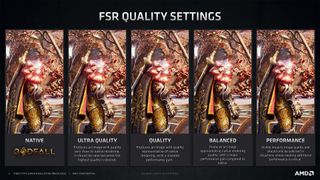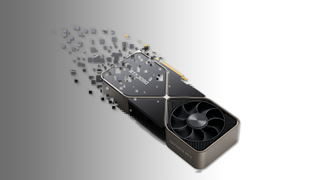The Nvidia-powered Nintendo Switch might be getting an unlikely performance boost from AMD
A Nintendo Switch Sports licence has been spotted with a note regarding AMD's FidelityFX Super Resolution upscaling technology.

Nintendo Switch Sports was announced last week, and I for one an pretty pumped to get my bowling shoes on and whiff a ball into the crowd. Before the game's launch this April, and before said whiffing can occur, we've caught glimpse of what could be a very interesting licence agreement with exciting implications for Nintendo's upcoming game and indeed console.
Spotted by NWPlayer123 on Twitter (via Videocardz), and reportedly a snap of a Nintendo Switch Sports licence, there's mention of AMD's FidelityFX Super Resolution (FSR). Now FSR is actually open-source, but the licence essentially outlines Nintendo's ability to do what it likes with the technology as it refers to the game.
found an interesting license from Nintendo Switch Sports, lists FidelityFX Super Resolution (FSR) pic.twitter.com/cfQKslK6SgFebruary 16, 2022
AMD's FidelityFX Super Resolution (FSR) technology is a pretty darn good way to hand yourself a performance boost in-game without really having to do much for it. You don't have to spend any money, at least. There is a slight degradation in visual fidelity with FSR enabled, as you're technically lowering the resolution then using mathematical magic to scale it back up again at less cost, but when done right you'd be hard pressed to notice it in the thick of in-game action.
The upscaling algorithm from AMD is enabled on a per-game basis on PC (though widely supported on Steam Deck, thanks to magic, I think), and will run on pretty much any graphics card you throw at it. There's a limit to how valuable it is on a really low-end or older graphics card, but there's nothing stopping you from trying it out. That applies to gamers with Nvidia's GPUs, too—FSR supports GeForce graphics cards from the green team.
So there's nothing stopping FSR coming to the Nvidia-powered Nintendo Switch, in theory. That said, the handheld console is powered by an Nvidia Tegra X1 processor using a slightly outdated GPU architecture in Nvidia's Maxwell. So you would expect to see an upscaling technology from Nvidia to make the cut before AMD managed to squeeze itself onto the console.
AMD makes the chips for the Xbox Series X and S, as well as the PlayStation 5.

But it's not like Nvidia can just ship Deep Learning Super Sampling (DLSS) onto the Switch and call it a day. Like I said, the Nintendo Switch GPU is based on a pretty old GPU architecture, and one that doesn't have the prerequisite AI-accelerating cores, called Tensor Cores, that the RTX 30- and 20-series GPUs do.
The biggest gaming news, reviews and hardware deals
Keep up to date with the most important stories and the best deals, as picked by the PC Gamer team.
That leaves Nvidia Image Scaling (NIS), which was Nvidia's answer to AMD's Radeon Super Resolution (RSR).
Bear with me here. There are a lot of initialisms for varying upscaling technologies today, which definitely doesn't help things.
NIS and RSR are more generalised upscaling technologies that do not require per-game optimisation or whatever sorcery Valve and AMD have cast to get FSR working on Steam Deck across titles. Both NIS and RSR are less effective than DLSS and FSR as a result, and perhaps that's not what Nintendo was after.

Gaming performance has long been determined by the size of a GPU, but the next big leap in fps could realistically come from upscaling technology.
In the end, there's nothing stopping the Switch from supporting FSR that I know of. The drivers might need a little tweaking and I doubt it's as straightforward as copying those files over from PC and calling it a day. But as a shader-based solution, FSR should work on basically any GPU going.
We don't yet know if Nintendo is absolutely going ahead with FSR. A licence for the technology in one of its games is a sign that something's afoot, but it's far from a smoking gun. It's an exciting prospect either way, though, as use of an upscaler could be the best way for Nintendo to push the envelope of graphical quality without needing newer, more powerful graphics inside a whole new console—we all know how difficult new silicon is to get in 2022, and that's still somewhat true even if you're Nintendo.
I'm sure that, no matter what happens here, we'll see upscaling technologies play a more pivotal role in consoles in the near-future. They're just too good at what they do to be ignored for long. AMD and Nvidia are the key proponents of the tech today, but Intel and even game engines, such as Unreal Engine 5, are beginning to get involved. It's a whole new battlefield for gaming performance, and it's only just getting started.

Jacob earned his first byline writing for his own tech blog. From there, he graduated to professionally breaking things as hardware writer at PCGamesN, and would go on to run the team as hardware editor. He joined PC Gamer's top staff as senior hardware editor before becoming managing editor of the hardware team, and you'll now find him reporting on the latest developments in the technology and gaming industries and testing the newest PC components.
Most Popular






